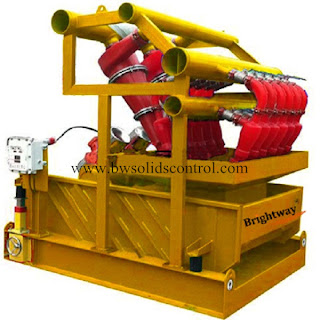Hydrocyclones are important in solids control systems because of their ability to efficiently remove particles smaller than the finest mesh screens. They are also uncomplicated devices, which make them easy to use and maintain.
 |
| Hydracyclone |
A hydrocyclone consists of a cylindrical/conical shell with a small opening at the bottom for underflow discharge, a larger opening at the top for liquid discharge through an internal “vortex finder”, and a feed nozzle on the side of the body near the cylindrical (top) end of the cone.
Drilling mud enters the cyclone using energy created by a centrifugal feed pump. The velocity of the mud causes the particles to rotate rapidly within the main chamber of the cyclone. Heavy, coarse solids and the liquid film around them tend to spiral outward and down-ward for discharge through the solids outlet. Light, fine solids and the liquid phase of the mud tend to spiral inward and upward for discharge through the liquid outlet.
Hydracyclone is used in our drilling fluids equipment such as desander, desilter, and mud cleaner. It is normally the 2nd or 3rd phase of the mud purifying system.
 |
| Desander |
 | ||
| Desilter
-The End-
Alice
|


No comments:
Post a Comment